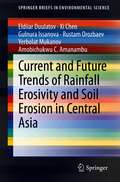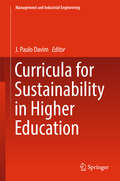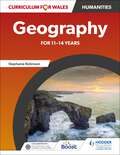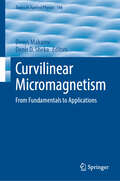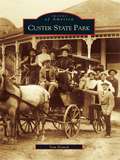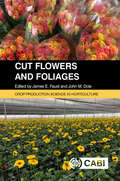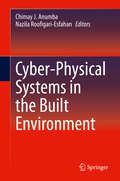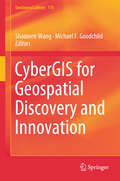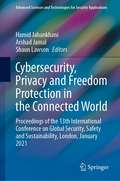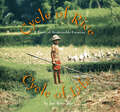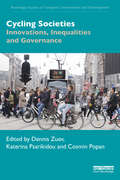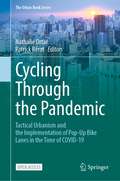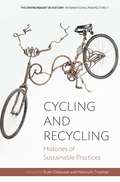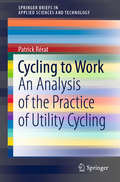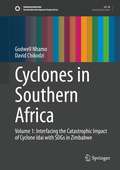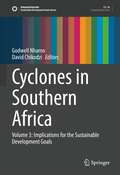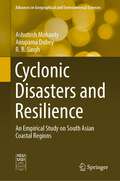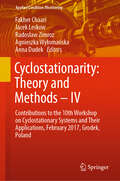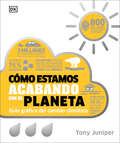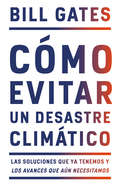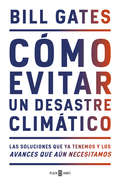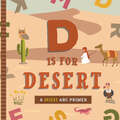- Table View
- List View
Current and Future Trends of Rainfall Erosivity and Soil Erosion in Central Asia (SpringerBriefs in Environmental Science)
by Xi Chen Gulnura Issanova Eldiiar Duulatov Rustam Orozbaev Yerbolat Mukanov Amobichukwu C. AmanambuThis book analyses climate change influences on rainfall erosivity and soil erosion across Central Asia, provides an overview (past and projections) on the Central Asian countries where projected changes in rainfall erosivity and erosivity density are the greatest, and discusses the potential impacts on the environment across the region. This analysis is accomplished primarily using the RUSLE model with past and future climate projections, spatiotemporal variations of rainfall erosivity and soil erosion based on WorldClim, and Coupled Model Intercomparison Project Phase 5 (CMIP5) climate models (for Central Asia and separately Kazakhstan). The relationship between precipitation characteristics and erosion has been well established, but spatial and temporal projections of future rainfall erosivity in a changing climate in Central Asia have not been published significantly. Therefore, assessing rainfall erosivity and its consequences can assist specialists and researchers in achieving the best practices for soil conservation. The result of this type of research is all-encompassing, and may reflect normal variations in other parts of the world (for example, the arid and semi-arid regions) and is inherently limited to the Central Asian region.
Curricula for Sustainability in Higher Education (Management and Industrial Engineering)
by J. Paulo DavimThis books presents the curricula necessary for sustainability in higher education. It shows how the learning process is transforming in order to promote sustainability. It prepares administrators, teachers and students to diffuse the development in the field, showing a curricula based on three interconnected pillars: the environment, the economic and the social aspects. It contains 8 chapters introducing research advances in the field.
Curriculum for Wales: Geography for 11–14 years
by David Gardner Stephanie Robinson Catherine Owen Jo Coles John LyonEmbodying the aims of the new curriculum for Wales, and forming part of the Humanities Area of Learning and Experience, Curriculum for Wales: Geography for 11-14 years will help you plan your curriculum, offering 18 chapters packed full of geographical resources, including maps, charts, diagrams and data.>> Build students' curiosity about the world around them - how it developed, what it is like now, and what it could be like in the future by helping you develop an enquiry-based approach to learning.>> Explore geography at a local, national and global scale and foster students' sense of cynefin with a focus on Wales and its place on the wider world.>> Develop core geographical skills with fieldwork enquiries embedded into the context of topics, encouraging students to investigate their local area.>> Support teachers in planning and assessment with suggested learning objectives.>> Help students to consider topics in the context of their own lives and the local area in which they live with regular 'My place' activities.>> Encourage students to think about the impact of human actions in their local area, on Wales and the world, to develop ethical informed citizens.>> Choose from crucial content areas including: weather and climate; ecosystems; landscapes and national parks; rural and urban places; sport and culture; climate change; disease; global consumers and more.
Curvilinear Micromagnetism: From Fundamentals to Applications (Topics in Applied Physics #146)
by Denys Makarov Denis D. ShekaThis is the first book providing overview of magnetism in curved geometries, highlighting numerous peculiarities emerging from geometrically curved magnetic objects such as curved wires, shells, as well as complex three-dimensional structures. Extending planar two-dimensional structures into the three-dimensional space has become a general trend in multiple disciplines across electronics, photonics, plasmonics and magnetics. This approach provides the means to modify conventional and even launch novel functionalities by tailoring the local curvature of an object. The book covers the theory of curvilinear micromagnetism as well as experimental studies of geometrically curved magnets including both fabrication and characterization. With its coverage of fundamental aspects, together with exploration of numerous applications across magnonics, bio-engineering, soft robotics and shapeable magnetoelectronics, this edited collection is ideal for all scientists in academia and industry seeking an overview and wishing to keep abreast of advances in the novel field of curvilinear micromagnetism. It provides easy but comprehensive access to the field for newcomers, and can be used for graduate-level courses on this subject.
Custer State Park
by Tom DomekCuster State Park is one of the largest and most beautiful state parks in the nation. From towering granite spires and pine-draped mountains to trout streams and remote savanna, the park offers scenic wonders and recreational opportunities seldom matched on the Northern Great Plains. First established as a state forest in 1912, today the park is home to one of the largest bison herds in the country, as well as other rare flora and fauna. Prior to settlement, the Black Hills were Lakota territory. After gold was discovered along French Creek in 1874, the government waged war on the Lakota, forcing them onto reservations, and settlers rushed to the region. Photos and narrative in this book provide an intriguing overview of the park's rich natural and social history. Whether the subject is Cathedral Spires or Sylvan Lake, General George Custer or Black Elk, Custer State Park will engage those who value history and the last few unspoiled places left in the country.
Customer Service Games for Training (Routledge Revivals)
by Graham Roberts-PhelpsThis title was first published in 2011.After World War II, a systems approach to solving complex problems and managing complex systems came into vogue among engineers, scientists, and managers, fostered in part by the diffusion of digital computing power.Enthusiasm for the approach peaked during the Johnson administration, when it was applied to everything from military command and control systems to poverty in American cities. Although its failure in the social sphere, coupled with increasing skepticism about the role of technology and "experts" in American society, led to a retrenchment, systems methods are still part of modern managerial practice.
Cut Flowers and Foliages (Crop Production Science in Horticulture)
by Raul I Cabrera Elizabeth Cieniewicz Melissa Muñoz Henry WainwrightThe cut flower and foliage industry is a global business with major production locations in North America, South America, Central America, East Africa, Europe, the Middle East, Asia, Australia and New Zealand. Few other horticulture crops are as ubiquitous, yet the production techniques and challenges are universal. This book describes the main international production locations and markets, including current trends and directions. The focus is on production in protected cultivation. The major species - including rose, chrysanthemum, carnation, orchid and gerbera - dominate the global market and these are individually explored in detail. Specialty species and cut foliages are also addressed, as well as significant details of production, including irrigation and fertilization, disease and disease management, and biological control of pests. Finally, the postharvest chapter covers details of harvesting, transporting and delivering high quality flowers that provide an excellent vase life. Highly illustrated with color photos throughout, this is an essential resource for students and researchers in horticulture, growers and producers, and those in the floriculture industry.
Cyber-Physical Systems in the Built Environment
by Chimay J. Anumba Nazila Roofigari-EsfahanThis book introduces researchers and practitioners to Cyber-Physical Systems (CPS) and its applications in the built environment. It begins with a fundamental introduction to CPS technology and associated concepts.It then presents numerous examples of applications from managing construction projects to smart transportation systems and smart cities. It concludes with a discussion of future directions for CPS deployment in the construction, operation and maintenance of constructed facilities. Featuring internationally recognized experts as contributors, Cyber-Physical Systems in the Built Environment, is an ideal resource for engineers, construction managers, architects, facilities managers, and planners working on a range of building and civil infrastructure projects.
CyberGIS for Geospatial Discovery and Innovation (GeoJournal Library #118)
by Michael F. Goodchild Shaowen WangThis book elucidates how cyberGIS (that is, new-generation geographic information science and systems (GIS) based on advanced computing and cyberinfrastructure) transforms computation- and data-intensive geospatial discovery and innovation. It comprehensively addresses opportunities and challenges, roadmaps for research and development, and major progress, trends, and impacts of cyberGIS in the era of big data. The book serves as an authoritative source of information to fill the void of introducing this exciting and growing field. By providing a set of representative applications and science drivers of cyberGIS, this book demonstrates how cyberGIS has been advanced to enable cutting-edge scientific research and innovative geospatial application development. Such cyberGIS advances are contextualized as diverse but interrelated science and technology frontiers. The book also emphasizes several important social dimensions of cyberGIS such as for empowering deliberative civic engagement and enabling collaborative problem solving through structured participation. In sum, this book will be a great resource to students, academics, and geospatial professionals for leaning cutting-edge cyberGIS, geospatial data science, high-performance computing, and related applications and sciences.
Cybersecurity, Privacy and Freedom Protection in the Connected World: Proceedings of the 13th International Conference on Global Security, Safety and Sustainability, London, January 2021 (Advanced Sciences and Technologies for Security Applications)
by Hamid Jahankhani Arshad Jamal Shaun LawsonThis book provides an opportunity for investigators, government officials, systems scientists, strategists, assurance researchers, owners, operators and maintainers of large, complex and advanced systems and infrastructures to update their knowledge with the state of best practice in the challenging domains whilst networking with the leading representatives, researchers and solution providers. Drawing on 12 years of successful events on information security, digital forensics and cyber-crime, the 13th ICGS3-20 conference aims to provide attendees with an information-packed agenda with representatives from across the industry and the globe. The challenges of complexity, rapid pace of change and risk/opportunity issues associated with modern products, systems, special events and infrastructures. In an era of unprecedented volatile, political and economic environment across the world, computer-based systems face ever more increasing challenges, disputes and responsibilities, and whilst the Internet has created a global platform for the exchange of ideas, goods and services, it has also created boundless opportunities for cyber-crime. As an increasing number of large organizations and individuals use the Internet and its satellite mobile technologies, they are increasingly vulnerable to cyber-crime threats. It is therefore paramount that the security industry raises its game to combat these threats. Whilst there is a huge adoption of technology and smart home devices, comparably, there is a rise of threat vector in the abuse of the technology in domestic violence inflicted through IoT too. All these are an issue of global importance as law enforcement agencies all over the world are struggling to cope.
Cycle of Rice, Cycle of Life: A Story of Sustainable Farming
by Jan ReynoldsA photographic exploration of the cycles of traditional Balinese rice farming, a dynamic model of earth-friendly agriculture that connects a unique culture with the natural world.On the island of Bali in Southeast Asia, rice farming is a way of life. The people live in tune with the natural rhythms and cycles of the water and the soil. Ingrained in their community and culture, rice farming connects them to the land and one another. Balinese farmers have planted rice using an intricate system of water sharing and crop rotation for more than a thousand years. Intertwined with their spiritual, social, and day-to-day lives, this system has made Bali a leading producer of one of the world's most important crops. And because Balinese rice farming respects the balances of nature, it serves as a remarkable example of sustainable agriculture in an increasingly industrialized world. With lush photographs and captivating text, Jan Reynolds explores the traditional world of rice farming on the beautiful island of Bali. Readers of all ages will come away with an enhanced awareness of how we farm, eat, and live today, and the effects these practices have on the world of tomorrow.
Cycling Societies: Innovations, Inequalities and Governance (Routledge Studies in Transport, Environment and Development)
by Dennis Zuev; Katerina Psarikidou; Cosmin PopanThis book examines emerging debates and questions around cycling to critically analyse and challenge dominant framings and prevalent conventions of ‘good cycling’. Cycling Societies brings to light the plurality of voices and forms of cycling in other societies, revealing the diversity and complexity of cycling across different socio-political regimes, geographies and cultures. It presents case studies from five continents and demonstrates the need of thinking comparatively about cycling and urban environments. The book pivots around the three themes of innovations, inequalities and governance and engages a diversity of voices: world-renowned academics in the field of cycling and urban mobility, cycling activists and transportation consultants. Synthesising academic contributions with policy briefs, this innovative book will be of great interest to students, scholars and practitioners of sustainable transportation, urban planning and mobility studies.
Cycling Through the Pandemic: Tactical Urbanism and the Implementation of Pop-Up Bike Lanes in the Time of COVID-19 (The Urban Book Series)
by Patrick Rérat Nathalie OrtarThis open access book provides insight on how the tactical urbanism has the capacity to influence change in mobility practices such as cycling. COVID-19 crisis prompted the public authorities to rethink the use of public space in order to develop means of transport that are both efficient and adapted to the health context and their effects on cycling practices in Europe, North, and South America. Its contributors collectively reveal and evidence through policies analysis, mapping, and innovative qualitative analysis bridging video and interviews, how those new infrastructures and policies can be a trigger for change in a context of mobility transition.This book provides an important element on the way local authorities can act in a quicker and more agile way. While some decisions are specific to the context of the beginning of the pandemic, the analysis offers lessons on the way to implement the transition toward a low-carbon mobility, on the importance of processes based on trials and errors, on the political stakes of reallocating road space.
Cycling and Recycling: Histories of Sustainable Practices (Environment in History: International Perspectives #7)
by Ruth Oldenziel Helmuth TrischlerTechnology has long been an essential consideration in public discussions of the environment, with the focus overwhelmingly on creating new tools and techniques. In more recent years, however, activists, researchers, and policymakers have increasingly turned to mobilizing older technologies in their pursuit of sustainability. In fascinating case studies ranging from the Early Modern secondhand trade to utopian visions of human-powered vehicles, the contributions gathered here explore the historical fortunes of two such technologies—bicycling and waste recycling—tracing their development over time and providing valuable context for the policy successes and failures of today.
Cycling to Work: An Analysis of the Practice of Utility Cycling (SpringerBriefs in Applied Sciences and Technology)
by Patrick RératThis book presents a thorough discussion of utility cycling, cycling in the urban environment, and everyday mobility. It is based on large survey answered by 14,000 participants in the bike to work action in Switzerland, and quantifies the various dimensions of utility cycling.It proposes an innovative theoretical framework to analyse and understand the various dimensions of the uses of bikes and their diversity. It addresses the factors that motivate commuters to get on their bike, and highlights the barriers to this practice between deficient infrastructures and lack of legitimacy. This research makes a diagnosis and discusses the way to develop this sustainable mode of transportation. By combining quantitative results in the form of tables, figures, and maps, and including qualitative results in the form of quotations from survey participants, this book provides a thorough and enjoyable read. It will be of interest to researchers, policy makers, advanced students in the field of urban planning, social sciences, and transportation.
Cyclones in Southern Africa: Volume 1: Interfacing the Catastrophic Impact of Cyclone Idai with SDGs in Zimbabwe (Sustainable Development Goals Series)
by Godwell Nhamo David ChikodziThere is evidence that the world has been witnessing more intense tropical cyclones. Accompanying these tropical cyclones are heightened levels of devastation that witness the loss of human life and wildlife, destruction of natural resources and property and the disruption of major economic and social activities. To this end, there is a growing demand for publications focusing on tropical cyclones at various levels that include regional, national and local levels, especially from Africa. One sub-region that has been witnessing the harsh realities of the increasing intensity of tropical cyclones in southern Africa. However, within this region, countries are usually impacted at varying degrees of damage. Among the countries that usually encounter the harshness of these tropical cyclones are the Comoros, Botswana, Madagascar, Mauritius, Malawi, Mozambique, Reunion, the Seychelles, South Africa and Zimbabwe. From the history books, the following tropical cyclones made landfall and hit southern Africa: Eline (2000), Favio (2007), Dineo (2017), Idai (2019), Kenneth (2019), Eliose (2021), and Chalane (2020). Although all these tropical cyclones had negative impacts, it is undoubtedly Tropical Cyclone Idai that shocked the world with its devastation mainly in Mozambique, Malawi and Zimbabwe in March 2019. Key infrastructure was destroyed, livelihoods were lost, and the environment was degraded. Thousands of people died, many more were injured, many remain unaccounted for and others remained homeless as of the time of finalising this book in February 2021. This book, therefore focuses on the devastating impacts of Tropical Cyclone Idai in Zimbabwe. The book interfaces Tropical Cyclone Idai’s impacts with the 2030 Agenda for Sustainable Development and some of the 17 Sustainable Development Goals (SDGs). This linkage was deliberate given that there is still time remaining until 2030, and the world has generally agreed to move into the future along the pathways of sustainable development and sustainability. The book adds to the first comprehensive profiling of the impacts of tropical cyclones on southern African economies, particularly that of Zimbabwe. It also comes up as the first in a three-volume series. The other volumes to look out for are Cyclones in Southern Africa Vol 2: Foundational and Fundamental Topics; and Cyclones in Southern Africa Vol 3: Implications for the Sustainable Development Goals. To this end, this book is suitable as a read for several professionals and disciplines such as tourism and hospitality studies, economics, sustainable development, development studies, environmental sciences, arts, geography, life sciences, politics, planning and public health.
Cyclones in Southern Africa: Volume 2: Foundational and Fundamental Topics (Sustainable Development Goals Series)
by Godwell Nhamo Kaitano DubeThe subject of tropical cyclones in Southern Africa, also known as hurricanes or typhoons in other regions of the world, has been growing over the past few decades. However, there is still limited literature on foundational and fundamental topics on the matter. To this end, this book addresses this gap, citing some examples from both historic and recent tropical cyclones. The book presents meteorological and climatic aspects of tropical cyclones, including reviews on forecasting, warning message dissemination and public response aspects of early warning systems with a focus on the Tropical Cyclones Idai and Kenneth. Fundamentals in disaster risk reduction (DRR) are also discussed moving from the provisions of the Hyogo Framework for Action (2005–2015), to the Sendai Framework for Disaster Risk Reduction (2015–2030). Climate change issues are central to the publication, as well as the role of information and communication technologies in DRR and management. The book also tackles some challenges and opportunities associated with the implementation of regional legal and institutional frameworks on DRR. The book comes as part of a series with three volumes. The other volumes include “Cyclones in Southern Africa Vol. 1: Interfacing the Catastrophic Impact of Cyclone Idai with SDGs in Zimbabwe” and “Cyclones in Southern Africa Vol 3: Implications for the Sustainable Development Goals”. To this end, this book is suitable as a read for several professionals and disciplines such as tourism and hospitality studies, economics, sustainable development, development studies, environmental sciences, arts, geography, life sciences, politics, planning and public health.
Cyclones in Southern Africa: Volume 3: Implications for the Sustainable Development Goals (Sustainable Development Goals Series)
by Godwell Nhamo David ChikodziTropical cyclones in Southern Africa, also known as hurricanes or typhoons in other regions of the world, is a hot subject for academic research. This focus has been magnified by the need to consider tropical cyclones in the context of other global development agendas, that includes the 2030 Agenda for Sustainable Development and its inseparable 17 Sustainable Development Goals (SDGs), the Paris Agreement, the Sendai Framework for Disaster Risk Reduction and Habitat III’s New Urban Agenda. The ambitious SDGs challenge global and community leaders to make sure development addresses the nexus among poverty, inequality and employment creation, as well as care for the earth and its natural resources and biodiversity. The SDGs further present an agenda to eradicate hunger, bring quality education and sustain water and sanitation. The infrastructure development, human settlements, sustainable consumption and production, climate change, biodiversity and the ocean (blue) economy agendas are also pitched. Lastly, the 2030 Agenda for Sustainable Development encourages partnerships on delivering various programmes and projects at all spatial levels. However, as tropical cyclones continue to make multiple landfalls and ravage Southern Africa and other parts of the world, the achievement of the 2030 Agenda for Sustainable Development is threatened. To this end, this book addresses this gap by documenting the implications of tropical cyclones, drawing examples and case studies from recent tropical cyclones such as cyclone Idai and cyclone Kenneth that resulted in catastrophic impacts in 2019. The book comes as part of a series with three volumes. The other volumes include “Cyclones in Southern Africa Vol. 1: Interfacing the Catastrophic Impact of Cyclone Idai with SDGs in Zimbabwe” and “Cyclones in Southern Africa Vol 2: Foundational and Fundamental Topics”. Given the foregoing, the book is suitable as a read for several professionals and disciplines such as tourism and hospitality studies, economics, sustainable development, development studies, environmental sciences, arts, geography, life sciences, politics, planning and public health.
Cyclonic Disasters and Resilience: An Empirical Study on South Asian Coastal Regions (Advances in Geographical and Environmental Sciences)
by R. B. Singh Anupama Dubey Ashutosh MohantyThe Bay of Bengal is prone to tropical cyclones and storm surges as a result of its location, and many of the mostly poor people living along the coastal regions of South Asia lose their lives almost every year. These disasters have been particularly devastating and have caused serious damage. During the past five decades, the low-lying coastal and offshore islands have experienced a tragic history of 50 severe cyclones and storm surges, with more than one million victims dead or missing. People accepted and waited for the next disaster as they had no alternatives. Members of the poor families who survived the disasters experienced hard times recovering from damage and the loss of their loved ones. After disasters, epidemic diseases arise in the affected areas. Many of the people in distress are also deprived of public services. Providing all sorts of assistance and emergency health preparedness are most essential to overcome such a situation. The causes of these huge casualties have been mainly: (1) the high population density of costal settlements, (2) inadequate cyclone shelters in the disaster risk areas, (3) lack of awareness of the disaster risk by the vulnerable population, (4) deterministic attitudes of people who accept disasters as “fate”, (5) houses that are weakly constructed and (6) underdeveloped central awareness programmes and weather forecast systems. This book is based on an empirical study presenting a timeline analysis of major cyclones and their impacts and consequent losses through the super-cyclones in the disaster-prone coastal regions of India, Sri Lanka and Bangladesh. This study also investigates resilience mechanisms based on early warning systems, technology applications including GIS and remote sensing, best practices, success stories and case studies that can be used for effective cyclone management and development of a resilience mechanism among coastal communities.
Cyclostationarity: Contributions to the 10th Workshop on Cyclostationary Systems and Their Applications, February 2017, Grodek, Poland (Applied Condition Monitoring #16)
by Fakher Chaari Jacek Leskow Radoslaw Zimroz Anna Dudek Agnieszka WyłomańskaThis book gathers contributions presented at the 10th Workshop on Cyclostationary Systems and Their Applications, held in Gródek nad Dunajcem, Poland in February 2017. It includes twelve interesting papers covering current topics related to both cyclostationary and general non stationary processes. Moreover, this book, which covers both theoretical and practical issues, offers a practice-oriented guide to the analysis of data sets with non-stationary behavior and a bridge between basic and applied research on nonstationary processes. It provides students, researchers and professionals with a timely guide on cyclostationary systems, nonstationary processes and relevant engineering applications.
Cómo estamos acabando con el planeta (How We're F***ing Up Our Planet): Guía gráfica del cambio climático
by Tony JuniperDiez millones de personas cada año se ven afectadas por inundaciones costeras y la contaminación por plásticos es una amenaza constante para la vida marina. La pandemia, el cambio climático, la superpoblación, el consumismo, la polución...¿tienen solución? Cómo estamos acabando con el planeta resuelve todas tus dudas sobre los retos y dificultades a los que se enfrenta el mundo en el que vivimos. - Imágenes, gráficos y datos claros para una mejor comprensión de aspectos como la polución, el calentamiento global, la deforestación o los patrones climáticos - Mensajes positivos e ideas para hacer de nuestro planeta un lugar mejor donde vivir - Cifras y comparativas por años de la población, del aumento de las energías renovables, de personas desplazadas... - Basado en las últimas investigaciones científicasEsta guía explicativa te invita a aprenderlo todo sobre los temas ambientales más actuales y a reflexionar cómo los problemas mundiales impactan nuestras vidas.
Cómo evitar un desastre climático
by Bill GatesEn este libro urgente y necesario Bill Gates propone un plan amplio, práctico y comprensible para conseguir que el mundo llegue a cero emisiones de gases de efecto invernadero para así evitar una catástrofe climática. Bill Gates ha pasado una década investigando las causas y efectos del cambio climático. Con la ayuda de expertos en los campos de la física, la química, la biología, la ingeniería, las ciencias políticas y las finanzas, se ha centrado en investigar exactamente qué se debe hacer para detener la deriva del planeta hacia un desastre ambiental. En este libro, además de explicar por qué debemos esforzarnos en lograr emisiones netas cero de gases de efecto invernadero, también detalla lo que debemos hacer para lograr este objetivo tan importante. Gates nos presenta una descripción clara de los desafíos que enfrentamos. A partir de su conocimiento sobre innovación y lo que se requiere para introducir nuevas ideas en el mercado, describe las áreas en las que la tecnología ya está ayudando a reducir las emisiones, dónde y cómo la tecnología actual puede funcionar de manera más eficaz, dónde es necesario desarrollar tecnologías de punta, y quién está trabajando en estas innovaciones esenciales. Finalmente, presenta un plan concreto y práctico para lograr el objetivo de cero emisiones, sugiriendo no solo las políticas que los gobiernos deberían adoptar, sino lo que nosotros, como individuos, podemos hacer para que nuestro gobierno, nuestros empleadores y nosotros mismos nos responsabilicemos esta crucial iniciativa. Como deja claro Bill Gates, llegar a cero emisiones no será sencillo ni fácil, pero si seguimos el plan que aquí propone, es una meta que se encuentra decididamente a nuestro alcance. Para detener el calentamiento global y evitar los peores efectos del cambio climático, los humanos deben dejar de agregar gases de efecto invernadero a la atmósfera. Si nada cambia, el mundo seguirá produciendo gases de efecto invernadero, el cambio climático seguirá empeorando y el impacto en los seres humanos con toda probabilidad será catastrófico. Pero las cosas pueden cambiar. Este libro trata sobre lo que se necesitará para lograrlo y por qué estoy convencido de que podemos hacerlo. -- Bill Gates
Cómo evitar un desastre climático: Las soluciones que ya tenemos y los avances que aún necesitamos
by Bill GatesEn este libro tan necesario y riguroso, Bill Gates expone un plan amplio, funcional y, sobre todo, asequible, para reducir a cero las emisiones de los gases causantes del efecto invernadero y evitar a tiempo una catástrofe medioambiental. Bill Gates ha dedicado una década a investigar el cambio climático. Con la orientación de expertos en física, química, biología, ingeniería, ciencias políticas y finanzas, se ha centrado en determinar qué medidas debemos tomar para detener la carrera del planeta hacia un desastre ambiental irreversible. En este libro, el autor no solo reúne la información básica para que tomemos conciencia de la necesidad de eliminar las emisiones de los gases causantes del efecto invernadero, sino que también explica qué debemos hacer para alcanzar este objetivo tan importante. Gates nos ofrece una descripción lúcida de los desafíos a los que nos enfrentamos. Aprovechando sus conocimientos en innovación y en lo que supone introducir nuevos conceptos en el mercado, nos detalla cuáles son los campos en los que la tecnología ya está ayudando a reducir las emisiones, cómo y cuándo se logrará que la tecnología actual sea más eficaz, dónde necesitamos dichos avances y quiénes están trabajando en estas mejoras tan necesarias. Por último, traza un plan práctico y específico para llegar a las cero emisiones, tanto con políticas gubernamentales como a título personal, implicando así a gobiernos, a empresas y a nosotros mismos en esta crucial misión. Como advierte Bill Gates, cumplir el objetivo de las cero emisiones no será una tarea sencilla, pero sí está a nuestro alcance si seguimos sus pautas.
D Is for Desert: An ABC Desert Primer
by Ashley Marie MirelesA is for armadillo B is for bedrock C is for cactus . . . With E for erosion, I for iguana, and P for prickly pear, going from A to Z has never been more fun in the sun! Take an alphabetized trip through the dunes and discover the plants, animals, and weather patterns that make the deserts of the world so amazing!
DGT-based Measurement of Phosphorus in Sediment Microzones and Rhizospheres
by Shengrui Wang Zhihao WuThis book focuses on the development of DGT (diffusive gradientsin thin films) and the related techniques for measuring and investigating the geochemicalprocess and P transfer across the sediment/water or sediment/root interface inlakes. A series of DGT techniques such as new types of probes, test methods in sediment or the rhizosphere,DIFS (DGT induced fluxes in sediments and soils)model for kinetic P exchange, CID (computer imaging densitometry) for S(-II), andmicrochelex gel/LA-ICP-MS (laserablation inductively coupled plasma mass spectrometry) have been developed. The corresponding chapters on the theory andmethodology of DGT, the "internal P loading" or P transfer across sediment/rootin two lakes, provide insights into the research method and conclusions, includingthe P release mechanism, the quantification of "internal P loading", kinetic Pexchange in DGT/sediment interface, Fe- or S(-II)-microniches at submillimeterscales in sediments for the prediction of P release, and DGT as a surrogate for the prediction of P uptakeby roots. It alsooffers new perspectives in the fields of P analysis and P process inmicro-interfaces in lakes using DGT techniques. The P remobilization fromFe-bound P, the coupled Fe-S(-II)-P geochemical reaction and algae biomassbreakdown causing P release, are elucidated using DGT methods in sedimentlayers. DGT parameters and curves for time or distancederived from DIFS can be used to assess kinetic Prelease in the sediment microzone. CID and LA-ICP-MS methods deliver Fe- andS(-II) images at submillimeter scales, which can be used for the quantificationof flux related to microniche peaks and the prediction of P release fromFe-microniche or Fe-S(-II)-P geochemical reactions. DGT measurements in-situ inrhizosphere or rhizonbox cangive CE (effectiveconcentration) and CDGTvalues for the prediction of P accumulated in plant tissues. This book provides a valuable reference resource for senior graduatestudents, lecturers and researchers in the fields of the geochemical process ofeutrophic elements in lakes, lake eutrophication mechanism and environmental analysis.
